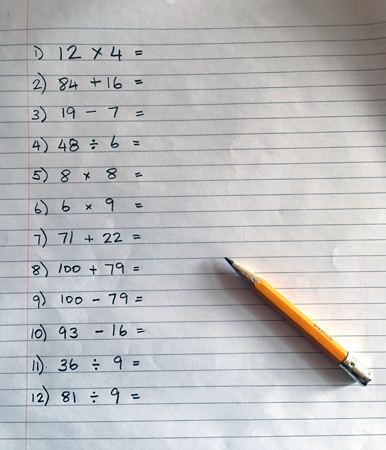At the grocery store I recently paid for $92 worth of groceries. I asked for $60 cash back on my purchase. The cashier froze, paused and stammered “Ok, soooo…. How much will that be?” The bagger saved the day and helped with the math.
I was shocked that 92+60 caused so much difficulty. What surprised me more over the next month was how often a cashier stumbled with similar, simple “mental math.”
Sigh…
Mental Math
The Ontario Ministry of Education defines mental math as: “Doing calculations in the mind, with little or no use of paper and pencil or calculator.”

In practical ways, simple, mental math means almost instantly knowing the answer – in your head – to questions like 92+60.
Or 12×8.
Or 100-87.
Why is this important?
There are practical reasons. When you’re at the checkout it’s nice to verify that the cashier is giving the correct change, quickly, without the need of a calculator. Mistakes happen more often than I’d like to think.
In a bigger life context mastering mental math is useful to everyday tasks.
I’m talking about figuring out how much paint to buy for a room that is 11 feet by 9 feet with 8 foot ceilings (320 square feet of wall space, not accounting for window or door or ceiling.)
… Or figuring out how much it will cost to take 8 kids to a birthday party movie at $8 each plus snack pack of $4.
In the classroom, mental math is crucial for higher level math. I’m not talking about 3rdyear university calculus. Word problems and bigger concepts will suffer if all the student’s mental energy revolves around simple math calculations.
The National Research Council found that “The more automatically a procedure can be executed, the less mental effort is required. Since each person has a limited amount of mental effort that he or she can expend at any one time, more complex tasks can be done well only when some of the subtasks are automatic.” (NRC, 2001)
What do we do to help our children?
I believe it is important for students to learn simple math by rote… so that the answer to 92 + 60 is automatic. They should learn simple math including times tables by memory.
How can students acquire this knowledge? It’s not fancy. Practice.
Activity 1
In elementary classes I do short “Mad Mental Math” by placing 20 simple math questions around the room on “vertical, non permanent surfaces”. I encourage students to work quickly, support each other. There are no calculators allowed! It’s exciting, fun and involves all levels of math students.
Activity 2
I’ll also do a game-show style quiz where students answer simple math questions verbally or on paper. It’s lightning fast, a little crazy and fun.
For both activities, we go over the answers as a class and ask students to explain strategies they found useful to figure out the answers.
If young students automatically know simple mental math, bigger concepts come more easily…
References
• Laura Wheeler. nd. “Visibly random groups & Vertical non-permanent surfaces.” https://mslwheeler.wordpress.com/2014/11/09/visibly-random-groups-vertical-non-permanent-surfaces/
• National Research Council. (2001). “Adding it up: Helping children learn mathematics.” Washington, DC: National Academies Press. (page 351) – sourced from “Focusing on the Fundamentals of Math: A TEACHER’S GUIDE,” below.
• Ontario Ministry of Education. (2018). “Focusing on the Fundamentals of Math: A TEACHER’S GUIDE.”http://www.edu.gov.on.ca/eng/teachers/teacher_guide_math_en.pdf
